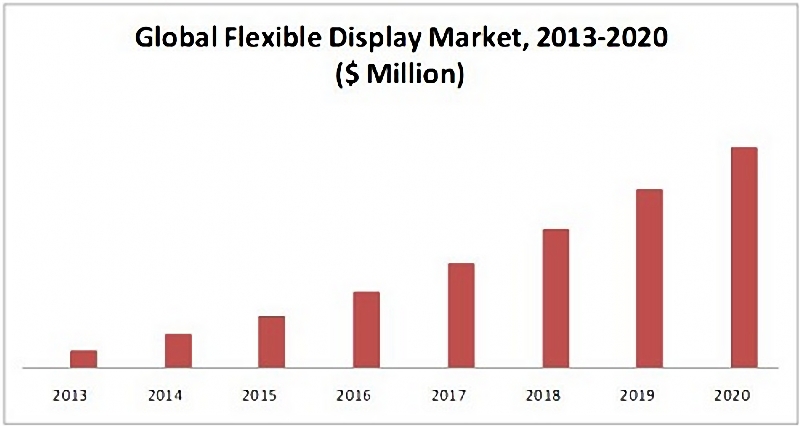Flexible OLED Market Global Industry Analysis and Forecast to 2020
01-06-2015Flexible OLED (Organic Light Emitting Diode) enables the device in which it is used to roll or bend while still operating. An OLED emits light because of the presence of thin films of organic semiconductors of thickness approximately 100 nanometers. The regular OLEDs are made on a glass substrate, and flexible OLEDs use flexible plastic such as polyethylene terephthalate (PET). The replacement of glass with PET also reduces weight of the device. Flexible OLED market is in the starting phase; however it is expected to rise much in the near future owing to the fast growth of electronics industry. OLEDs also find their application in the production of electronic paper or bendable displays that can be combined into clothing, wallpaper or other curved surfaces.
The key drivers of flexible OLED market includes technological improvement by several industries and growing per capita income which is encouraging customers to buy electronic products with flexible display. The continuous research and development activities in the domain of flexible OLED market hold opportunity for the expansion of this market.
There are few limitations associated with the flexible OLEDs such as stress introduced into the organic layers may lower the efficiency or brightness of the device as it is unusal, or cause complete failure of the device altogether. Package is another challenge for flexible OLED devices. Flexible package methods are generally not as effective a barrier to air and moisture as glass; however research and development in this area are being done to improve the package of flexible organic light emitting diodes.
Based on application, flexible OLEDs can be assembled into mobile phones, tablets and notebooks, Televisions, automotive and aerospace, wearable electronics, industrial, micro-displays and others. The automotive and aerospace application segment followed by televisions is growing at fastest pace. Amazon, the e-commerce company has been making extensive use of flexible OLEDs in his e-paper products. Among wearable electronics, flexible OLEDs are growing has a huge opportunity in the space of smart watches and fitness bands which uses flexible OLEDs of below 2 inches.
Based on materials use flexible OLED market can be divided into Crystalline and Amorphous and Solution-Castable Amorphous. Crystalline flexible OLEDs can be further segmented into three categories namely PET, Polyethylene Naphthalate (PEN) and Poly-Ether-Ether Ketone (PEEK). Amorphous and Solution-Castable Amorphous can be divided into two categories namely Polycarbonate and Polyethersulphone. Based on technology, flexible OLED market can be categorized into five categories namely PM OLED, P-OLED, PH OLED, AM OLED and SM OLED.
One of the major barriers for the flexible OLED market is in the form of manufacturing challenges due to increasing skilled labor market and complex manufacturing process. Existing glass display is another hindrance for the flexible OLED market which has a high demand due to relatively lower price.
North America dominates the global sales of flexible OLED market, followed by Europe. The Asia Pacific market is also seeing a fast growth. The major companies in flexible OLED market include Atmel Corporation, Sony Corporation, Dupont Display, Delta Electronics, Nokia, Philips Electronics, Hewlett-Packard Company, Corning Inc., Delta Electronics Inc. and Plastic Logic Inc. Most of of flexible OLED companies are based in U.S. and Taiwan.



